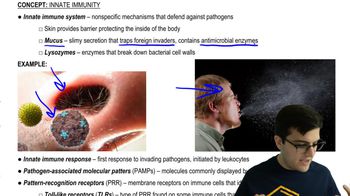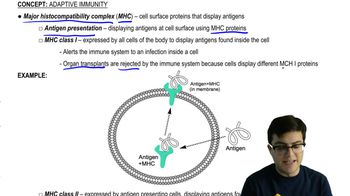- 1. Introduction to Biology2h 40m
- 2. Chemistry3h 40m
- 3. Water1h 26m
- 4. Biomolecules2h 23m
- 5. Cell Components2h 26m
- 6. The Membrane2h 31m
- 7. Energy and Metabolism2h 0m
- 8. Respiration2h 40m
- 9. Photosynthesis2h 49m
- 10. Cell Signaling59m
- 11. Cell Division2h 47m
- 12. Meiosis2h 0m
- 13. Mendelian Genetics4h 41m
- Introduction to Mendel's Experiments7m
- Genotype vs. Phenotype17m
- Punnett Squares13m
- Mendel's Experiments26m
- Mendel's Laws18m
- Monohybrid Crosses16m
- Test Crosses14m
- Dihybrid Crosses20m
- Punnett Square Probability26m
- Incomplete Dominance vs. Codominance20m
- Epistasis7m
- Non-Mendelian Genetics12m
- Pedigrees6m
- Autosomal Inheritance21m
- Sex-Linked Inheritance43m
- X-Inactivation9m
- 14. DNA Synthesis2h 27m
- 15. Gene Expression3h 20m
- 16. Regulation of Expression3h 31m
- Introduction to Regulation of Gene Expression13m
- Prokaryotic Gene Regulation via Operons27m
- The Lac Operon21m
- Glucose's Impact on Lac Operon25m
- The Trp Operon20m
- Review of the Lac Operon & Trp Operon11m
- Introduction to Eukaryotic Gene Regulation9m
- Eukaryotic Chromatin Modifications16m
- Eukaryotic Transcriptional Control22m
- Eukaryotic Post-Transcriptional Regulation28m
- Eukaryotic Post-Translational Regulation13m
- 17. Viruses37m
- 18. Biotechnology2h 58m
- 19. Genomics17m
- 20. Development1h 5m
- 21. Evolution3h 1m
- 22. Evolution of Populations3h 52m
- 23. Speciation1h 37m
- 24. History of Life on Earth2h 6m
- 25. Phylogeny2h 31m
- 26. Prokaryotes4h 59m
- 27. Protists1h 12m
- 28. Plants1h 22m
- 29. Fungi36m
- 30. Overview of Animals34m
- 31. Invertebrates1h 2m
- 32. Vertebrates50m
- 33. Plant Anatomy1h 3m
- 34. Vascular Plant Transport2m
- 35. Soil37m
- 36. Plant Reproduction47m
- 37. Plant Sensation and Response1h 9m
- 38. Animal Form and Function1h 19m
- 39. Digestive System10m
- 40. Circulatory System1h 57m
- 41. Immune System1h 12m
- 42. Osmoregulation and Excretion50m
- 43. Endocrine System4m
- 44. Animal Reproduction2m
- 45. Nervous System55m
- 46. Sensory Systems46m
- 47. Muscle Systems23m
- 48. Ecology3h 11m
- Introduction to Ecology20m
- Biogeography14m
- Earth's Climate Patterns50m
- Introduction to Terrestrial Biomes10m
- Terrestrial Biomes: Near Equator13m
- Terrestrial Biomes: Temperate Regions10m
- Terrestrial Biomes: Northern Regions15m
- Introduction to Aquatic Biomes27m
- Freshwater Aquatic Biomes14m
- Marine Aquatic Biomes13m
- 49. Animal Behavior28m
- 50. Population Ecology3h 41m
- Introduction to Population Ecology28m
- Population Sampling Methods23m
- Life History12m
- Population Demography17m
- Factors Limiting Population Growth14m
- Introduction to Population Growth Models22m
- Linear Population Growth6m
- Exponential Population Growth29m
- Logistic Population Growth32m
- r/K Selection10m
- The Human Population22m
- 51. Community Ecology2h 46m
- Introduction to Community Ecology2m
- Introduction to Community Interactions9m
- Community Interactions: Competition (-/-)38m
- Community Interactions: Exploitation (+/-)23m
- Community Interactions: Mutualism (+/+) & Commensalism (+/0)9m
- Community Structure35m
- Community Dynamics26m
- Geographic Impact on Communities21m
- 52. Ecosystems2h 36m
- 53. Conservation Biology24m
41. Immune System
Immune System
Problem 2
Textbook Question
Foreign molecules that elicit an immune response are called a. major histocompatibility complex (MHC) molecules. b. antibodies. c. histamines. d. antigens.
 Verified step by step guidance
Verified step by step guidance1
Identify the role of each option in the immune system.
Understand that major histocompatibility complex (MHC) molecules help display antigens on cell surfaces for recognition.
Recognize that antibodies are proteins produced by the immune system to neutralize or destroy foreign substances.
Note that histamines are involved in inflammatory responses and are released by cells in response to injury and in allergic and inflammatory reactions.
Conclude that the molecules that specifically elicit an immune response by being recognized as foreign by the immune system are called antigens.
Recommended similar problem, with video answer:
 Verified Solution
Verified SolutionThis video solution was recommended by our tutors as helpful for the problem above
Video duration:
1mPlay a video:
Was this helpful?
Key Concepts
Here are the essential concepts you must grasp in order to answer the question correctly.
Antigens
Antigens are foreign molecules, often proteins or polysaccharides, that trigger an immune response when detected by the body. They can originate from pathogens like bacteria and viruses, or from non-infectious sources such as pollen or transplanted tissues. The immune system recognizes these molecules as non-self, leading to the activation of immune cells and the production of antibodies.
Recommended video:
Guided course

Antigen Receptors
Immune Response
The immune response is the body's defense mechanism against foreign invaders, including pathogens and antigens. It involves the recognition of antigens by immune cells, which then activate various pathways to eliminate the threat. This response can be innate (immediate and non-specific) or adaptive (specific and slower, involving memory cells for future protection).
Recommended video:
Guided course

Innate Immune Response
Major Histocompatibility Complex (MHC)
The Major Histocompatibility Complex (MHC) is a set of molecules displayed on cell surfaces that play a crucial role in the immune system's ability to recognize foreign substances. MHC molecules present peptide fragments from proteins, including antigens, to T cells, facilitating the activation of the adaptive immune response. There are two main classes: MHC class I (present on all nucleated cells) and MHC class II (primarily on antigen-presenting cells).
Recommended video:
Guided course

Major Histocompatibility Complex

 9:33m
9:33mWatch next
Master Immune System with a bite sized video explanation from Jason Amores Sumpter
Start learningRelated Videos
Related Practice



















